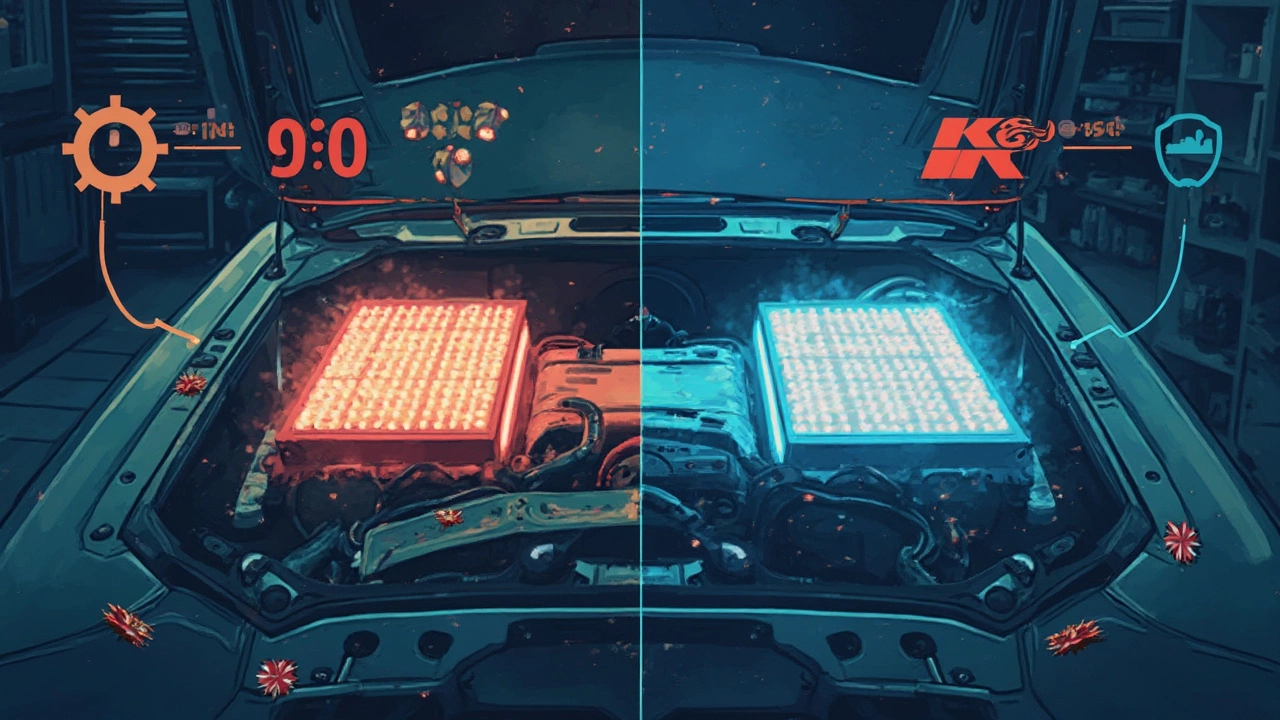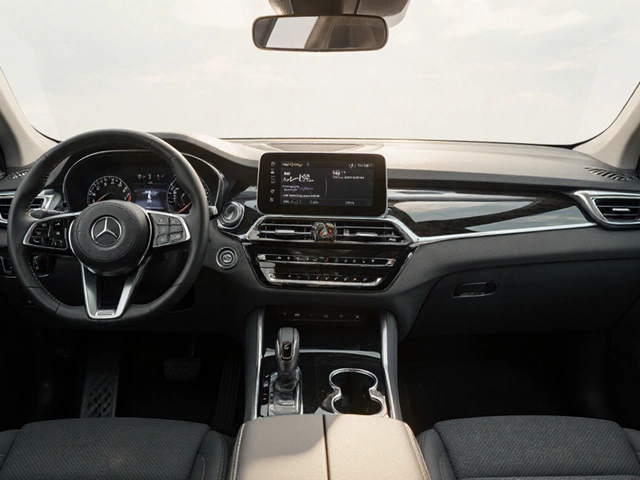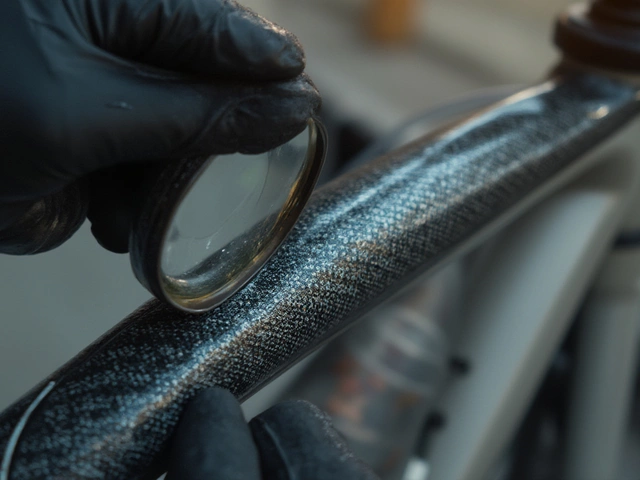K&N filters are everywhere in the car enthusiast world, but are they actually worth it? If you've ever wandered through an auto parts store or got lost in an online forum, you've probably seen heated debates about these high-flow air filters. Some folks swear by the boost in horsepower and the idea of never buying another filter again. Others worry about engine damage or question if the extra airflow really makes a difference.
If you're thinking about swapping your regular paper filter for a reusable K&N, it's not just about a brand name—it's about how it changes your car's breathing. This filter lets in more air, which can help your engine get a little extra kick, especially if you pair it with other upgrades. But it's not all rainbows—there are a few things you have to watch out for, like cleaning it the right way and watching for oil issues that could mess with sensors.
There's also more to consider than just "Will my car go faster?" Things like how often you drive, what kind of roads you hit, and how much work you put into maintenance all play a part. It's not a simple yes or no answer. Stick around and you'll get the clear, honest rundown—real pros, real cons, and real tips for making the most out of your K&N filter.
- What Makes K&N Filters Different?
- Performance Gains: Fact vs. Hype
- Maintenance and Longevity
- Potential Downsides and Risks
- Tips for Getting the Most Out of Your K&N Filter
What Makes K&N Filters Different?
Most regular car air filters are made from paper, which does a decent job of keeping out dirt but restricts airflow. K&N filters take a different route—they use layers of cotton gauze sandwiched between wire mesh. That seems simple, but here's the kicker: this setup lets in a lot more air than plain paper, which helps your engine breathe easier.
The cotton layers are also soaked in special filter oil. This sticky oil catches the tiny dirt you don’t want in your engine while still letting plenty of air through. The result? You get a reusable filter that can be cleaned and put back in, instead of tossing it out every 10,000 miles like a regular one. K&N claims each filter can last up to 1 million miles if you keep up with cleaning.
If you love data, here’s a quick comparison between standard and K&N filters based on manufacturer stats:
| Feature | Standard Paper Filter | K&N Performance Filter |
|---|---|---|
| Airflow | Lower | Higher |
| Filter Media | Pleated Paper | Oiled Cotton Gauze |
| Reusable | No | Yes |
| Cleaning Interval | 10,000 – 15,000 miles | 50,000 miles (under normal driving) |
| Lifespan | Single use | Up to 1 million miles |
Another cool thing: K&N filters are custom-made for tons of car and truck models, so you usually don’t need to mess around with cutting or forcing a universal part to fit. Just drop it in—done.
But before you jump in, know that the actual performance boost depends on your car setup. If everything else is stock, the gains might be tiny. Pair it with other mods, though, and you might notice your engine sounds throatier and picks up RPMs quicker. For a lot of folks, that alone is worth it.
Performance Gains: Fact vs. Hype
Everyone wants their car to be a little quicker, but does swapping to a K&N filter really deliver that punch? Here’s the deal—K&N claims their high-flow air filters can boost horsepower and throttle response because they let in more air compared to stock paper filters. Airflow definitely matters for engine performance, but the effect isn’t always night and day, especially on a stock engine.
Independent dyno tests have found typical power gains in the ballpark of 1-4 horsepower on everyday vehicles. It’s not going to turn your sedan into a racecar, but a couple extra horses can make throttle response a bit snappier, especially if your factory filter was old or clogged. Where you’ll see more of a difference is when the filter is just one piece of the puzzle—combined with upgrades like a performance exhaust or ECU tune, that extra airflow gets more useful.
Check out some numbers from real-world tests:
| Vehicle Type | Stock Filter | K&N Filter | Estimated HP Gain |
|---|---|---|---|
| 2019 Honda Civic | 174 HP | 176 HP | +2 HP |
| 2017 Ford F-150 | 375 HP | 378 HP | +3 HP |
| 2021 Toyota Corolla | 139 HP | 140 HP | +1 HP |
Now, for K&N filters on turbocharged or highly tuned engines, the gains can be a bit higher because those engines really depend on maximum airflow. But on a bone-stock daily driver, don’t expect giant numbers.
There’s another side to all this. Since these performance air filters let in more air by being less restrictive, they can also let in a bit more dirt if you skip maintenance. So, if you’re chasing every single horsepower—or if you just want a filter you can reuse and forget about—you need to think about the full picture.
- Don't expect huge power jumps unless you have other mods to go with the filter.
- Maintenance matters. A dirty K&N filter won’t help performance and could harm your engine.
- If you love hearing the engine intake growl, K&N filters do give a slightly deeper sound, which some folks really like.
Bottom line: There are real gains, but they’re modest. If you’re itching for a noticeable boost, you’ll need a bigger upgrade plan than just swapping in a K&N filter.

Maintenance and Longevity
One of the biggest reasons folks switch to a K&N filter is the whole “never buy another air filter again” selling point. These filters are built to last for the life of your car if you clean and re-oil them the right way. But it’s not totally hands-off—they need a bit of regular love.
K&N recommends cleaning your filter every 50,000 miles under normal driving, but if you’re in a dusty area, you’ll want to check it more often—maybe every oil change or 10,000 miles. Letting dirt cake up too much can choke your engine, killing the performance you’re after. Here’s what a good maintenance routine looks like for these performance air filters:
- Remove the filter and tap it gently to shake loose the big stuff like leaves or bugs.
- Spray it with a K&N filter cleaner (never use soap or other degreasers).
- Let it soak for about 10 minutes, then rinse from the clean side to the dirty side with low-pressure water.
- Let it air dry fully—don’t rush it with a heat gun or compressed air.
- Once totally dry, lightly re-oil the filter using K&N’s specific oil. More oil is not better. Go too heavy and you risk messing up your mass airflow (MAF) sensor.
Skip the right steps or overdue the oil, and you can actually hurt your car. There are lots of stories on truck forums about MAF sensors getting gunked up from over-oiled K&N filter elements. If you see your check engine light pop on after cleaning, odds are it's too much oil.
On the bright side, you could save real money over time because a K&N filter is reusable. Check out this quick comparison:
| Filter Type | Change Interval | Cost Per Unit (USD) | Cost Over 150,000 miles |
|---|---|---|---|
| OEM Paper Filter | 15,000 miles | $18 | $180 |
| K&N Filter | Clean every 50,000 miles | $60 (one-time) | $60 |
With a K&N filter, you only pay once and spend a bit on cleaning kits later. In the long run, if you stick with the same car, it adds up. Just remember: the filter doesn’t last forever if you abuse it. Wash and oil it wrong, or ignore regular checks, and you’re back to buying new parts just like everyone else.
Potential Downsides and Risks
Now, let’s be real—K&N filter reviews aren’t always glowing. There are some real trade-offs you need to know before you grab one off the shelf. First up: filtration. The whole point of a stock air filter is to keep gunk out of your engine. K&N filters use an oiled cotton material, which allows better airflow, but studies have found they can let through more fine dust compared to those boring factory paper filters. If you drive on a lot of dirt or gravel roads, this risk definitely goes up. More dust inside equals faster wear on things like the piston rings and cylinder walls.
Then there’s the oil situation. A K&N filter works because it’s oiled—but too much oil can mess with your mass airflow sensor (MAF). If you over-oil the filter after cleaning, the extra oil can coat the sensor and throw off air/fuel readings. That means your car might run rough, use more fuel, or even throw a check engine light. If you’re not handy with maintenance, this can get annoying fast.
Some manufacturers even warn that any aftermarket performance air filters like K&N might void your powertrain warranty if something goes wrong. So if you’ve got a new ride and the warranty is a big deal to you, it’s worth checking the fine print before swapping your filter.
- Lower filtration compared to OEM paper filters (riskier if you drive in dusty places)
- Possible MAF sensor issues from extra oil
- Extra maintenance—cleaning and re-oiling every 30,000-50,000 miles
- Potential warranty issues on newer cars
| Filter Type | Typical Filtration Efficiency | Maintenance Needed |
|---|---|---|
| OEM Paper | 97-99% | Replace every 15-20k miles |
| K&N Oiled Cotton | 95-98% | Wash and re-oil every 30-50k miles |
A lot of folks jump into K&N filter upgrades thinking it’s all upside, but these details matter. If you’re willing to clean and oil it right, and you aren’t driving on dust roads every day, you might not see these issues. But skip the maintenance, or slap too much oil on, and problems can pop up fast.

Tips for Getting the Most Out of Your K&N Filter
If you want the best from your K&N filter, it pays to know how to use it right. These filters can last a million miles, but only if you take care of them. Here’s what really works:
- Don’t skip cleaning schedules. K&N says you can go up to 50,000 miles between cleanings under normal conditions, but if you drive in dusty areas or hit the backroads a lot, play it safe and check your filter every oil change. It’s way easier to clean it sooner than deal with clogged airflow.
- Use the K&N cleaning kit. Don’t just rinse it with water or use random cleaners. K&N’s cleaner and oil are made for this exact job, so grab the real deal. This prevents under- or over-oiling, which can mess up your MAF sensor and cause other headaches.
- Let it dry completely. After you wash the filter, patience is key. Don’t put it back in while it’s even a little damp—moisture can ruin the filtration and mess with your car’s sensors.
- Avoid over-oiling. After cleaning, use just enough oil. If you go overboard, you risk fouling your mass airflow sensor, which can trigger annoying check-engine lights.
If you’re all about squeezing every bit of performance from your car, consider pairing your K&N filter with a well-maintained intake system. Clogged airways or cracked hoses will hold you back no matter how good your filter is.
| Recommended Cleaning Intervals | Driving Style/Environment |
|---|---|
| 50,000 miles | Normal city/highway driving |
| 25,000 miles | Dusty or rural roads |
| After every off-road trip | Off-road or extreme conditions |
When storing your cleaning kit, keep it in your garage or trunk—not at home where you’ll forget it exists. That way, you’ll always have it handy when you get the urge (or reminder light) to maintain your K&N filter.
If you ever see oil residue inside your intake, it’s time to back off on the oil during your next cleaning. Little things like this go a long way in keeping your performance air filters running smooth and safe for a long haul.






